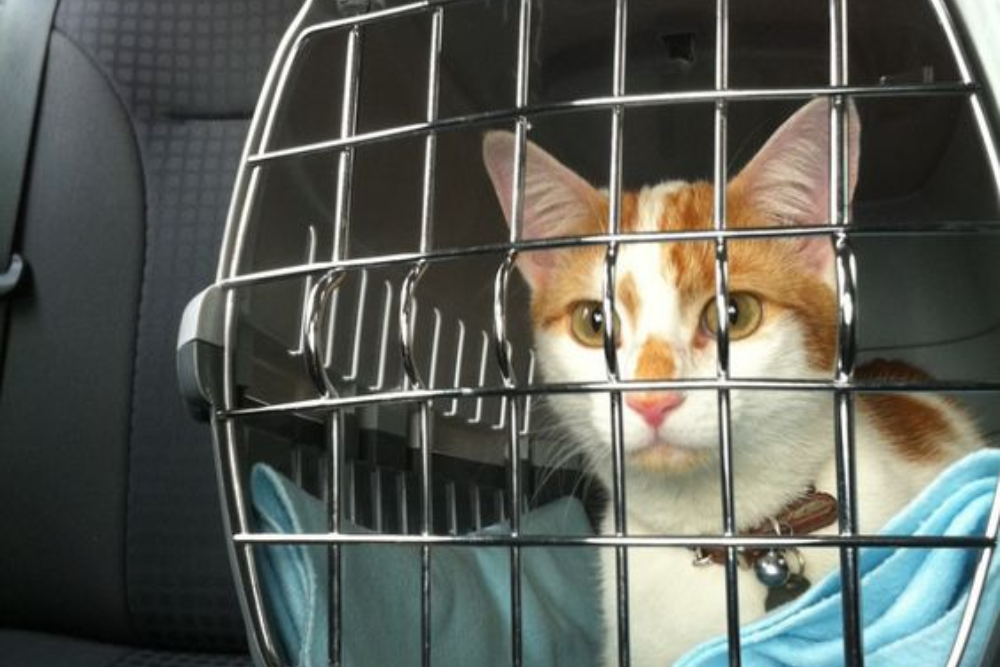Transporting cats across the country is a significant undertaking that requires meticulous planning and consideration for the well-being of your feline companions. In this extended guide, we’ll delve deeper into each aspect of transporting cats across country, providing additional information and insights to ensure a smooth and stress-free experience for both you and your beloved cats.
Ensure Up-to-Date Vaccinations
Before embarking on any long-distance journey, it’s imperative to ensure that your cats’ vaccinations are not only up-to-date but also tailored to the specific risks they might encounter during the trip. Discuss with your veterinarian about the regions you’ll be traveling through, as different areas may pose unique health challenges for your cats.
Additionally, inquire about preventive measures for common travel-related illnesses. Some vaccinations may need to be administered well in advance, so plan accordingly to ensure your cats have optimal protection.
Register Microchips Online
Microchipping is a crucial safety measure, but its effectiveness is heightened when you register the microchips online with a reputable pet recovery database. Provide detailed and up-to-date information, including multiple contact numbers and addresses, to increase the chances of a swift reunion if your cats get lost during the journey.
Select a Reliable Carrier
Choosing the right carrier goes beyond mere convenience. Consider factors such as the material of the carrier, its size, and the ease of cleaning. Opt for carriers with sturdy construction, proper ventilation, and a design that minimizes stress for your cats. Soft-sided carriers are often more comfortable for cats, as they allow for flexibility and can fit into various spaces.
Furthermore, consider familiarizing your cats with the carrier well before the journey. Leave it open in their living space, place treats or toys inside, and encourage positive associations to reduce anxiety during travel.
Pack a Kitty Essentials Bag
Creating a kitty essentials bag is a crucial step in ensuring that your cats have everything they need during the journey. This bag should include:
- Food and Water: Pack enough food for the entire trip, along with collapsible bowls for easy feeding. Staying hydrated is essential, so ensure an adequate supply of water.
- Medications and First Aid: Include any prescribed medications, along with a basic first aid kit for emergencies. Consult your vet for specific recommendations based on your cats’ health needs.
- Comfort Items: Bring familiar toys, blankets, or bedding to provide a sense of security for your cats. Familiar scents can help reduce stress during the journey.
- Litter and Litter Box: Use a travel-friendly cat litter and bring a portable litter box. Cats are particular about their litter, and maintaining a clean and familiar environment is crucial.
- Grooming Supplies: Pack grooming tools if your cats require regular grooming. This ensures that they remain comfortable and well-maintained throughout the journey.
Stay Calm While Packing
Your cats are highly attuned to your emotions, so maintaining a calm and composed demeanor during the packing process is crucial. If you sense any anxiety from your cats, reassure them with gentle strokes and comforting words. Familiar scents, such as your clothing or bedding, can also provide a sense of security during this potentially stressful time.
Introduce Cats to Their Travel Environment
Familiarizing your cats with their travel environment is key to reducing stress. Start by allowing them to explore the carrier or crate in a controlled and positive manner. Place treats and toys inside to create a positive association, making the carrier a comforting space.
Gradually increase the time your cats spend in the carrier, ensuring they become accustomed to the confined space. This step-by-step approach helps minimize anxiety and ensures a smoother transition when the journey begins.
ID Cats Properly while Transporting Cats Across Country
Proper identification is essential to ensure the safety of your cats during the move. Beyond microchipping, consider attaching a secure and legible ID tag to their collar. Include your current contact information and destination details. This additional measure provides a quick and visible way for others to identify and contact you in case of an emergency.
Secure Your Cats on Moving Day
Whether you’re traveling by car or plane, ensuring the safety of your cats on moving day is non-negotiable. For car travel, secure carriers with seat belts to prevent movement and potential injuries. When flying, adhere to airline guidelines for the proper labeling and secure confinement of your cats’ carriers.

Consider using a harness and leash during breaks to allow your cats some supervised exploration while keeping them under control. This additional freedom can help alleviate stress and provide a positive break during the journey.
Find Pet-Friendly Hotels
Researching and booking pet-friendly accommodations is paramount for overnight stays. Beyond just accepting pets, look for hotels that offer dedicated pet-friendly amenities, such as designated walking areas and in-room pet services. Some hotels may even provide welcome packages for your furry companions.
Start the Whole Process With Thorough Planning
Thorough planning is the foundation for a successful move with your cat. Consider the following steps:
- Visit the Vet: Schedule a visit to the vet well before the move to ensure your cats are in optimal health. Discuss any specific needs or concerns related to the journey.
- Update Records: Ensure that your cats’ microchip information and ID tags are up-to-date with your current contact details. This is crucial for quick identification and reunification in case of separation.
- Research Local Vets: Look for a new veterinarian in your destination area. Having a vet lined up ensures that you have immediate access to healthcare services if needed.
- Pack Gradually: Start packing gradually to avoid abrupt changes in the environment. Cats can be sensitive to disruptions, so maintaining a sense of normalcy for as long as possible is beneficial.
Plan for Car Travel
For those opting for a road trip, extensive planning for car travel is essential. Beyond short trips to acclimate your cats to the vehicle, consider factors such as climate control and rest stops. Cats may not enjoy car rides as much as dogs, so creating a comfortable and secure environment within the car is crucial.
Use familiar bedding and toys in the car to create a sense of continuity for your cats. Additionally, place their carriers in a secure location, ensuring they are not in direct sunlight and have proper ventilation.
Additional Tips for a Smooth Journey:
Bring Out Carriers Early
Encourage positive associations with the carriers by introducing them well in advance. Incorporate treats, play, and comforting scents to make the carriers a source of comfort for your cats. This proactive approach can significantly reduce anxiety during travel.
Give a Cat Some Space
During breaks or overnight stays, provide a designated space within the vehicle or accommodation where your cats can retreat and feel secure. This space should be equipped with familiar items to create a sense of continuity.
Spritz Before Traveling
Consider using calming sprays or pheromone diffusers within the carriers before embarking on the journey. These products can have a soothing effect on cats, promoting a more relaxed state during travel.
Consider the Cat Litter
The choice of cat litter can impact your cats’ comfort during the journey. Opt for a travel-friendly litter and maintain cleanliness in the carrier. Familiar substrate can provide a sense of security and encourage normal litter box behavior.
Keep Cats Hydrated
Proper hydration is crucial, especially during longer journeys. Use spill-proof bowls to prevent messes, and ensure an adequate supply of water for your cats. Monitor their water intake and encourage them to drink, particularly in warmer conditions.
Pack Comforting Smells
Include items with familiar scents in the carrier, such as their bedding or your clothing. Familiar smells can provide reassurance and a sense of security, helping to ease stress during travel.
Avoid Direct Sunlight
Protect your cats from direct sunlight exposure, whether you’re driving or flying. Use sunshades for car windows and choose shaded areas during breaks to prevent overheating. Cats are sensitive to temperature changes, and proper climate control is essential for their well-being.
It Will Take a Few Weeks for the Pet to Get Used to a New Space
After the upheaval of a move, it’s crucial to understand that patience is the cornerstone of helping your cats adjust to their new surroundings. Adapting to a new environment can be a gradual process for felines, and providing a supportive atmosphere during this transitional period is essential. Here’s a detailed breakdown of how to navigate the initial weeks after arriving at your new home:
The Adjustment Period:
Moving can be a stressful experience for cats, and the adjustment period varies for each feline companion. It’s not uncommon for cats to take a few weeks or even longer to feel entirely at ease in their new surroundings. During this time, observant and considerate care can significantly contribute to their well-being.

Creating a Safe Space:
One of the key strategies to facilitate a smooth adjustment is to create a designated safe space for your cats within your new home. This space should be:
- Quiet and Secure: Choose an area away from the hustle and bustle of the household, ensuring minimal noise and activity. This provides a tranquil environment where your cats can feel secure.
- Furnished with Familiar Items: Place familiar items such as their bed, toys, and blankets in this space. These belongings carry familiar scents and provide a sense of continuity from their previous environment.
- Equipped with Basic Necessities: Ensure the space has essential amenities like a water bowl and a litter box. Maintaining routine elements of their daily life helps in creating a comforting and predictable environment.
By designating a specific area that meets these criteria, you offer your cats a refuge where they can retreat to when feeling overwhelmed or uncertain.
Gradual Exploration:
Once the safe space is established, the next step is to encourage gradual exploration. While you might be eager for your cats to explore the entirety of their new home, it’s crucial to allow them to dictate the pace of their exploration. Here’s how you can facilitate this process:
- Open Access Gradually: Initially, keep doors closed to other areas of the house, gradually expanding access over time. This controlled introduction helps prevent overwhelming your cats with too much space all at once.
- Positive Reinforcement: Encourage exploration through positive reinforcement. Use treats, gentle praise, or playtime in different areas to create positive associations with the new spaces.
- Observe Comfort Levels: Pay close attention to your cats’ body language and behavior. If they seem hesitant or anxious, allow them to retreat to their safe space and proceed with the introduction more gradually.
- Avoid Forcing Exploration: Never force your cats to explore areas they seem uncomfortable with. Instead, let them take the lead, respecting their need for a gradual and self-paced adjustment.
By allowing your cats to explore at their own pace, you give them the autonomy to gradually familiarize themselves with their new home while feeling secure and in control.
Additional Considerations:
- Interactive Play: Engaging your cats in interactive play can be a great way to build positive associations with the new environment. Use toys to stimulate their interest and create a bond between you and your cats during this adjustment period.
- Quiet Bonding Time: Spend quiet bonding time in the safe space, offering gentle strokes and reassuring words. This helps strengthen your cats’ connection with you while providing comfort in their designated area.
- Monitor Interactions: If you have other pets or family members, monitor interactions carefully. Introduce them gradually and under supervision to ensure a positive and stress-free introduction.
- Routine Maintenance: Stick to your cats’ usual feeding and playtime routines. Consistency in their daily schedule provides a sense of stability, helping them adjust more smoothly.
The Importance of Patience:
Patience is undoubtedly the linchpin of this entire process. It’s natural to want your cats to feel at home immediately, but pushing the pace of their adjustment can lead to heightened stress and anxiety. By offering patience, understanding, and the right environment, you lay the foundation for a positive and successful transition to their new home.
Monitoring Behavioral Changes in the First Month or Two
Despite thorough planning and careful execution, the first month or two in the new space can be crucial. Keep a close eye on your cats for any sudden behavioral changes that might indicate distress:
- Body Language: Ears held back and a tucked tail are common signs that something might be wrong. These indicators can suggest anxiety or discomfort.
- Aggression: Unexplained aggression can be a sign of unhappiness. Monitor interactions with other pets or family members to ensure a smooth adjustment.
- Excessive Sleep: While cats are known for their love of napping, a noticeable increase in sleep may signal stress or unease.
- Lack of Appetite: A sudden lack of appetite is a concerning sign. If your cat stops eating, it’s essential to address the issue promptly.
By paying attention to these signs and addressing them promptly, you can ensure a smoother transition for your feline companions.
Breeds That Handle Change Better
While the challenges of moving with a cat are universal, some breeds are known for their resilience and adaptability to change. If you own one of these breeds, the move may be a less daunting experience:
1. Birman
Birmans are known for their gentle and adaptable nature. They tend to handle changes in their environment with relative ease, making them well-suited for relocations.
2. Ragdoll
Ragdolls are known for their calm demeanor and easygoing nature. They often adapt well to new environments, provided they receive the necessary care and attention.
3. American Shorthair
American Shorthairs are renowned for their versatility and adaptable personalities. They tend to adjust smoothly to changes in their surroundings.
4. Pixiebob
Pixiebobs are known for their intelligence and sociable nature. Their ability to form strong bonds with their owners contributes to their resilience in adapting to new environments.

5. Scottish Fold
Scottish Folds are known for their placid temperament. While they may initially be reserved in a new setting, they often adjust well over time.
6. Exotic Shorthair
Exotic Shorthairs, with their laid-back and affectionate nature, are generally more adaptable to change. They form strong bonds with their owners, aiding in a smoother transition.
Genetic Predisposition to Resilience
The adaptability of these breeds can be attributed to their genetic predisposition to a more resilient nature. While individual temperament varies, these breeds often possess traits that make them better equipped to handle the stress associated with a move.
- Calm Temperament: Breeds like Birmans and Ragdolls are known for their calm and placid temperaments, allowing them to navigate changes more smoothly.
- Versatility: Breeds like American Shorthairs and Pixiebobs are versatile, adapting well to new environments and situations.
- Strong Bonds: Cats such as Scottish Folds and Exotic Shorthairs tend to form strong bonds with their owners. This bond provides a source of comfort and security during a move.
Understanding the genetic factors that contribute to resilience in certain breeds can guide cat owners in selecting a companion that is better suited for a dynamic lifestyle that may involve relocation.
Frequently Asked Questions:
Driving or Flying?
The decision between driving and flying depends on various factors, including the distance, your cats’ comfort with travel, and personal preferences. Evaluate the pros and cons of each method and choose the one that aligns with your specific circumstances.
Why Should You Take Precautions When Moving a Cat?
Moving can be a stressful experience for cats, and taking precautions is vital to their well-being. Cats are creatures of habit, and changes in their environment can lead to anxiety and behavioral issues. Precautions to consider include:
- Gradual Acclimation: Allow your cats time to adjust to the new space by introducing them to different areas gradually. Provide a quiet and safe space initially and gradually expand their exploration.
- Monitoring Behavioral Changes: During the first month or two, pay close attention to behavioral changes. Signs of distress may include ears held back, aggression without reason, excessive sleep, or a lack of appetite. Addressing these issues promptly can prevent prolonged stress.
Look for Pet-Friendly Hotels
Beyond merely seeking pet-friendly hotels, consider hotels that go the extra mile to cater to the needs of your cats. Look for features like secure outdoor spaces and in-room amenities to make the overnight stays as comfortable as possible.
Consult with Your Current Vet and Look for a New One
Prior to the journey, consult with your current vet for guidance on preparing your cats for travel. Ensure you have updated copies of their medical records, including vaccination history and any prescribed medications. Additionally, research and identify a new vet near your new home, so you’re prepared in case of any unforeseen health issues.
How Long Does It Take a Cat to Adjust to a New Home?
The adjustment period varies for each cat and can range from a few days to several weeks. Observe your cats’ behavior and provide a supportive environment. Gradual introductions to different areas of the home and maintaining familiar routines can expedite the adaptation process.
How Can I Calm My Stressed Cat After Moving?
Moving can be stressful for cats, and calming strategies are essential. Create a quiet and safe space in your new home, preferably in a room with familiar items. Spend quality time with your cats, offering gentle reassurance. Consider using calming products, such as pheromone diffusers, to create a soothing atmosphere.
Successfully transporting cats across country requires a comprehensive and thoughtful approach. By incorporating these additional tips and insights into your travel plan, you can ensure a safe, comfortable, and positive experience for your feline companions. Remember to prioritize their well-being at every stage of the journey, and your cats will thank you with a smooth transition to their new home.


